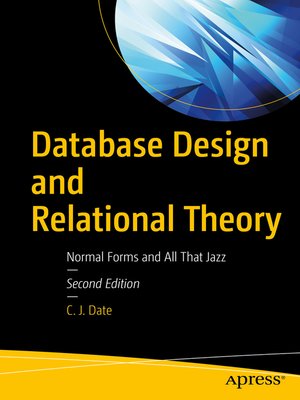
Sign up to save your library
With an OverDrive account, you can save your favorite libraries for at-a-glance information about availability. Find out more about OverDrive accounts.
Find this title in Libby, the library reading app by OverDrive.



Search for a digital library with this title
Title found at these libraries:
| Library Name | Distance |
|---|---|
| Loading... |
Create database designs that scale, meet business requirements, and inherently work toward keeping your data structured and usable in the face of changing business models and software systems.
This book is about database design theory. Design theory is the scientific foundation for database design, just as the relational model is the scientific foundation for database technology in general. Databases lie at the heart of so much of what we do in the computing world that negative impacts of poor design can be extraordinarily widespread.
This second edition includes greatly expanded coverage of exotic and little understood normal forms such as: essential tuple normal form (ETNF), redundancy free normal form (RFNF), superkey normal form (SKNF), sixth normal form (6NF), and domain key normal form (DKNF). Also included are new appendixes, including one that provides an in-depth look into the crucial notion of data consistency.Sequencing of topics has been improved, and many explanations and examples have been rewritten and clarified based upon the author's teaching of the content in instructor-led courses.
This book aims to be different from other books on design by bridging the gap between the theory of design and the practice of design. The book explains theory in a way that practitioners should be able to understand, and it explains why that theory is of considerable practical importance. Reading this book provides you with an important theoretical grounding on which to do the practical work of database design. Reading the book also helps you in going to and understanding the more academic texts as you build your base of knowledge and expertise. Anyone with a professional interest in database design can benefit from using this book as a stepping-stone toward a more rigorous design approach and more lasting database models.
What You Will LearnUnderstand what design theory is and is not Be aware of the two different goals of normalization Know which normal forms are truly significant Apply design theory in practice Be familiar with techniques for dealing with redundancy Understand what consistency is and why it is crucially important
Who This Book Is For
Those having a professional interest in database design, including data and database administrators; educators and students specializing in database matters; information modelers and database designers; DBMS designers, implementers, and other database vendor personnel; and database consultants. The book is product independent.
This book is about database design theory. Design theory is the scientific foundation for database design, just as the relational model is the scientific foundation for database technology in general. Databases lie at the heart of so much of what we do in the computing world that negative impacts of poor design can be extraordinarily widespread.
This second edition includes greatly expanded coverage of exotic and little understood normal forms such as: essential tuple normal form (ETNF), redundancy free normal form (RFNF), superkey normal form (SKNF), sixth normal form (6NF), and domain key normal form (DKNF). Also included are new appendixes, including one that provides an in-depth look into the crucial notion of data consistency.Sequencing of topics has been improved, and many explanations and examples have been rewritten and clarified based upon the author's teaching of the content in instructor-led courses.
This book aims to be different from other books on design by bridging the gap between the theory of design and the practice of design. The book explains theory in a way that practitioners should be able to understand, and it explains why that theory is of considerable practical importance. Reading this book provides you with an important theoretical grounding on which to do the practical work of database design. Reading the book also helps you in going to and understanding the more academic texts as you build your base of knowledge and expertise. Anyone with a professional interest in database design can benefit from using this book as a stepping-stone toward a more rigorous design approach and more lasting database models.
What You Will Learn
Who This Book Is For
Those having a professional interest in database design, including data and database administrators; educators and students specializing in database matters; information modelers and database designers; DBMS designers, implementers, and other database vendor personnel; and database consultants. The book is product independent.







